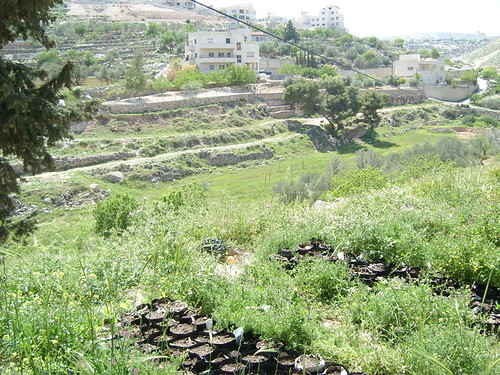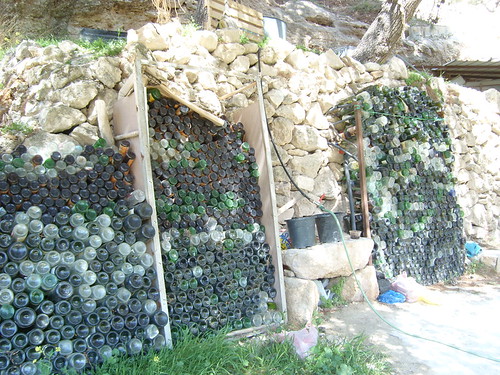A new type of solar panel using human hair could provide the world with cheap, green electricity, believes its teenage inventor.
Milan Karki, 18, who comes from a village in rural Nepal, believes he has found the solution to the developing world's energy needs.
The young inventor says hair is easy to use as a conductor in solar panels and could revolutionise renewable energy.
About iDW
iDW collects and features innovative solutions to these problems from all over the developed and underdeveloped world, and invites active feedback from its readers.
If you would like to publicize your own appropriate technology solutions, or have any suggestions for future features please contact iDW at: idw.news@gmail.com
Thursday, September 10, 2009
Nepalese Student invents $30 Solar panel using Human Hair
Tuesday, May 5, 2009
Students Develop Building Bricks from Cow Dung
 A team of several students from Prasetiya Mulya Business School in Indonesia have won the 2009 Global Social Venture Competition for their “EcoFaeBrick“ - an affordable and easily manufactured,sustainable building material made from cow dung. According to reports, the bricks are 20% lighter, with a compressive strength 20% stronger than clay bricks- and their production doesn’t rely upon quarry mining techniques harmful to the local environment.
A team of several students from Prasetiya Mulya Business School in Indonesia have won the 2009 Global Social Venture Competition for their “EcoFaeBrick“ - an affordable and easily manufactured,sustainable building material made from cow dung. According to reports, the bricks are 20% lighter, with a compressive strength 20% stronger than clay bricks- and their production doesn’t rely upon quarry mining techniques harmful to the local environment.Through the use of 75%cow manure and a cured biogas heating process that reduces the brick factory’s CO2 emissions significantly over traditional wood fire heat, the EcoFaeBricks help to provide an affordable economic solution to a waste problem while curbing the destruction of the local environment caused by clay quarries.
The group claims that the process will raise participating farmers’ incomes by 53%, which will not only help to raise their quality of life, but lead some former clay miners to begin to farm.
EcoFaeBrick's Website: EcoFaeBrick
Global Social Venture Competition Website: GSVC
Thursday, April 30, 2009
Vertical Garden with Reclaimed Gutters

"When Suzanne Forsling moved to Juneau Alaska from Iowa, she found that it was a little bit harder to get her garden to grow. Frustrated by cold soil, scarce sunlight, hungry slugs, root maggots, porcupines, cats, bears and ravens she got resourceful. She got her crops off the cold ground and into the light by afixing gutters to the wood siding of her house on the sunny side and using them as planters."Original Link: DYI
Friday, April 24, 2009
Permaculture - a Necessity for Palestinians
Originally published on Youthradio.org;

(All photos taken from Youthradio's public Flickr account)
By Nora Barrows-Friedman
"Back in my hometown of Berkeley, California, the practice of permaculture is associated within a feel-good, hippie-elite framework. It's a choice, just like buying locally grown organic heirloom tomatoes from an independent grocer instead of buying conventional Chilean-grown tomatoes hawked at Safeway. But inside the occupied West Bank, permaculture is not just a decision of conscience but a necessary means of empowerment within an ever-changing, uncertain landscape.
The reasons for this earth-friendly approach include accelerated loss of water-rich land to Israeli settlements, and Israeli restrictions on certain types of fertilizer and restrictions on what types of vegetables can be exported out of the occupied-territories. Out of creative necessity for food security, Palestinians have begun to re-green the land; reclaiming the ancient ways of growing crops.
Palestinians in the area say they are excited to participate in this burgeoning permaculture movement. "I was born here," Munther Rishmawi, a Beit Sahour resident says. "My grandfather farmed here on this same ground. And I'm learning to be a farmer in a new way...in Palestine, we don't have a lot. We just have land."Alice Harrison, an environmental scientist from the United Kingdom, came to Palestine as a tourist and was moved by the humanitarian and environmental fallout from the Israeli occupation. She helped start the Bustan Qaraaqa farm last year after working on water development at a Palestinian NGO. "We were writing these reports about the environment being destroyed," Harrison says. "From the top-down development level, nothing was happening to prevent the destruction of Palestine. So, instead of saying this is terrible, something must be done, we thought, this is terrible, what do we do now?"
Harrison says the practice of permaculture in Palestine is multi-faceted. "We're developing simple things that anyone can do in order to salvage something from the occupation...We're also responding to the economic crisis and the food security crisis."
Farmers at Bustan Qaraaqa say that over 70 different species of native plants are being propagated and rooted throughout this wadi (Arabic for desert valley). Tiny sprigs of ricinus and pale green thyme reach for the sky in their little pots made from the bottoms of plastic juice bottles. Sage and mint grow in soil-filled car tires, and almond and apricot saplings nurture wildflowers at the base of their skinny trunks. Permaculture is not a tidy, clean-cut way of farming. Instead, plants and trees are packed in all together, grouped by need for certain nutrients, sun or shade, The term "weeds" does not apply; permaculture insists that every plant has its place and can offer something beneficial to the landscape. In the nursery at Bustan Qaraaqa, long, thick blades of wild grass protect new sprouts from the blazing sun.Across the Green Line, Israeli agri-business flourishes and Israelis enjoy unrestricted access to land and water resources. Water grids and sophisticated irrigation provide an abundance of crops and full swimming pools during the summer. Even illegal Israeli settlements in the West Bank enjoy these privileges, while Palestinians in surrounding villages and refugee camps struggle with a fraction of the water supply.
According to a report published this week by the World Bank, the average Israeli receives access to four times as much water as the average Palestinian, resulting in what it calls a "near catastrophe" for the Palestinian Authority's current water system.
The green fields of vegetable and fruit crops in Israel are fed from water aquifers and the Jordan river as settlements across the West Bank are deliberately placed on top of the most fertile land and the biggest underground water tables. On the other hand, Palestinian farms, villages, towns and refugee camps (all of which are restricted from accessing the same water tables and the Jordan river) must then rely on rainwater-catching tubs on top of roofs and beside homes -- a meager source of water especially in the hot summer months.
Bustan Qaraaqa addresses this water crisis head-on. Volunteers are building a massive cistern on the southern edge of the property that will catch and reserve rainwater to be used for irrigation and fish farming; schools of tilapia will be introduced both as a form of mosquito control and as a source of food for the community.
"Palestine could lead the world in arid-zone agriculture," says Alice Harrison. "Already, 80% of the farming is rain-fed. It's a sustainable set-up to begin with -- but, it's predicted that, because of global climate change, rainfall in this area will decrease 20% by 2050. We should be prepared for it."
Working to re-green a drying land within an expanding humanitarian crisis, Bustan Qaraaqa farm volunteers are beginning to coordinate with Palestinian refugee camps, helping develop ideas for rooftop gardens and water re-use. "This isn't a movement for yuppies," Harrison continues. "This is a very grassroots concern. These are real problems people are facing." She quotes a Bedouin friend of hers. "He says that in the [Palestinian] environmental movement, this is a case of us recognizing ourselves."
Wednesday, April 22, 2009
RAM Pumps in the Philippines
Heating Homes - with Mirrors
"Practical Solar wants to bring solar thermal home, but in a somewhat unusual manner.
The company has created a system for harvesting heat from the sun to heat up a house. It plants heliostats – i.e., metal poles festooned with an array of mirrors – in your lawn or a nearby patch of real estate. The mirrors collect heat and then beam it into your living room.
A computerized control system guides the heliostats to maximize the harvesting of heat.
Although you'd think that something like this might sell best in the South, where it's hot, Practical is mostly targeting New England. It's the region where people need to heat their homes.
Solar thermal water heaters have been used to replace or supplement home water heaters or pool heaters for years. A number of companies – Sopogy, Chromasun, Millennium Solar and others – now want to expand how solar heat can be exploited. Chromasun, for instance, has a device that collects solar heat to run air conditioners. Some other companies use the heat for fluid pipe heating systems."
Read the full article here: Heating you home with Mirrors!
Visit Practical Solar's website here: Practical Solar






